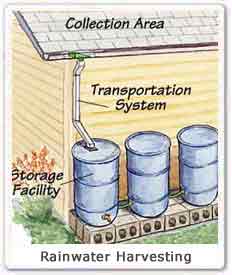 People
usually make complaints about the lack of water. During the monsoons lots of
water goes waste into the gutters. And this is when Rain water Harvesting
proves to be the most effective way to conserve water. We can collect the
rain water into the tanks and prevent it from flowing into drains and being
wasted. It is practiced on the large scale in the metropolitan cities. Rain
water harvesting comprises of storage of water and water recharging through
the technical process.
People
usually make complaints about the lack of water. During the monsoons lots of
water goes waste into the gutters. And this is when Rain water Harvesting
proves to be the most effective way to conserve water. We can collect the
rain water into the tanks and prevent it from flowing into drains and being
wasted. It is practiced on the large scale in the metropolitan cities. Rain
water harvesting comprises of storage of water and water recharging through
the technical process. Methods of Rainwater Harvesting :
Catchment :
Any surface or the paved areas can be treated as catchment. Even the footpaths and roads can act as the catchment, as these areas too receive the direct rainfall. Rooftops are the best among them because of the large coefficient of run off generated from them and there are less chances of contamination of water.
Conveyance :
Conveyance system basically includes rain gutters and down pipes which collects the rain water from catchment to the storage tank. These rain gutters are usually built during the time of construction. They need to be designed appropriately as to avoid the loss of water during the conveyance process.
Storage :
The most important part of the rain water harvesting is the storage system. The storage system is designed according to the amount of water that is to be stored. The design and site (location) of the storage or the recharge system should be properly chosen. The areas which receives the rainfall frequently, there a simple storage system could be constructed, to meet the daily water requirements. Otherwise the areas which receive the lesser rainfall, there the storage systems are quite essential. Rain barrels, underground or open slumps are mostly used to collect rain water. Make sure that the storage system is properly sealed and does nor leak. Use Chlorine from time to time to keep the water clean.
Benefits of Rainwater Harvesting : Rainwater harvesting first of all increases water security. It is the perfect solution to meet water requirements especially in the areas which do not have sufficient water resources. It helps in improving the quality of the ground water and increasing the level of the ground level. It also helps in improving the overall floral system. It reduces the loss of top layer of the soil. If we capture the water directly we need not to depend much on the water storage dams. It is the good solution to the increasing water crises. Rain water harvesting reduces the flooding on roads and further prevents it from contamination. And in the last it decreases the menace of floods on regional scale.






